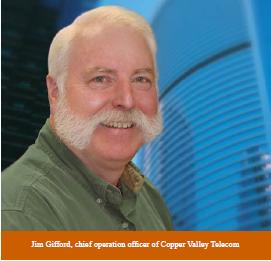CVT: Making Communication Easier for You

Jim Gifford, chief operation officer of Copper Valley Telecom (CVT), has been in the telecommunications business since 1977, starting with a background in CATV then moving over traditional wireline telephone services. CVT, a small company, has provided opportunities to become experienced in not only day-to-day operations but also engineering of new services ranging from switching, new soft switching, IT, fiber backbone, fiber to the premise, backbone microwave networks, Wi-Fi, AMPS and CDMA network, all in remote Alaska.
Now, Jim Gifford shares his insights into broadband network construction and differentiated competitiveness in the mobile broadband and smartphone era.
Journalist: Could you introduce your company, CVT (including CVW), and its business?
Jim Gifford: Copper Valley Telecom is a small rural telecommunications company providing wireline telephone and wireless services in South Central Alaska, covering a service area in excess of 9,600 square miles and a small population of 10,000. Copper Valley provides traditional wireline telephone, Internet and wireless CDMA EV-DO Rev. A services.
CVT is a member owned community based telecommunications cooperative, dedicated to providing the best value, state-of-the-art communication services to keep up with our customers’ needs.
Copper Valley Wireless (CVW) is the subsidiary company of CVT. CVW is mainly devoted to building wireless network and developing the wireless services.
Journalist: What are the objectives of CVT and CVW in 2011? What approaches will you take to achieve these objectives?
Jim Gifford: This year is shaping up to be another busy construction year for Copper Valley Telecom. As is the national trend, our objective is to bring broadband everywhere. CVT delivers broadband over fiber and copper cables, and wirelessly using both cellular 3G and Wi-Fi hot spots. Copper Valley’s focus during 2011 is to replace satellite fed connectivity with new terrestrial fiber and microwave networks to support broadband services. An initial deployment of fiber to the premise and VDSL service is underway as well.
Additional enhancements provide for redundancy and Internet connectivity upgrades. With the new transport facilities, new cell sites are being deployed along with capacity system upgrades. For example, we are also upgrading electronics in our central offices and electronics sites near subdivisions and homes to support faster and more reliable internet connections. CVT is also busy upgrading our Internet connections to the rest of the world to provide for e-commerce and over the top (OTT) services such as downloading of movie TV, gaming and entertainment.
In a word, you will see CVT employees and contractors busy working to bring broadband to more places where you work, live and play.
Journalist: Mobile internet, mobile broadband and smartphones are developing rapidly. CVT is a full-service operator. How does the company adjust its strategies to deal with development trends?
Jim Gifford: CVT will be the full service telecommunications provider of choice by offering cutting edge technology through innovative business approaches and competent, highly trained employees. With the rapid growth of wireless services, CVW has developed two cells on wheels (COW’s), which are deployed to different venues, such as the Ski Season on Thompson Pass, the summer tourist season supporting remote lodges on the Denali Highway and fill in service to relive service congestion as demand grows and changes. Additionally CVT is adding cell sites and transport capacity to support ever growing EV-DO usage. Our customers are hungry for bandwidth and until recently with CVT’s network expansion have been limited to satellite based services.
Journalist: How does your company differentiate itself from other bigger carriers in U.S.? And what advantages does your company have over these carriers?
Jim Gifford: CVT provides service in very remote low-density population areas, several of our service areas have no commercial electricity, limited or no road access, requiring travel by boat or air to reach the communities and cell sites. CVT maintains a number of standalone mountain top microwave/cell sites requiring helicopter only access, powered by solar, wind and cycled propane generators. We are a member owned local company, so our focus is serving our members and the remote areas they live, work and enjoy in the remote region of Alaska.
Journalist: In 2006, ZTE began cooperating with CVW on CDMA equipment. How do you evaluate ZTE’s products and services? What’s your expectation for future collaboration between CVT and ZTE?
Jim Gifford: In the remote areas and restricted access of our service area, mountain top cell sites, and extreme Alaska temperatures reaching -60 Fahrenheit during the winters, the ZTE CDMA network has exceeded our expectations on reliability and capacity power usage. The ZTE CDMA platform providing voice and EV-DO data to both mobile and fixed customers is an essential service business, residential and emergency communications.
CVT anticipates continued growth with ZTE of the 3G network with continued build out of cell sites providing additional coverage and capacity.
Journalist: Could you tell us about CVW’s planned evolution from CDMA to LTE?
Jim Gifford: CVW is planning an initial LTE deployment starting in 2012 and expects to operate a dual CDMA and LTE network for several years as the LTE network is extended from the villages and towns out to the more rural and remote areas of our vast service areas.